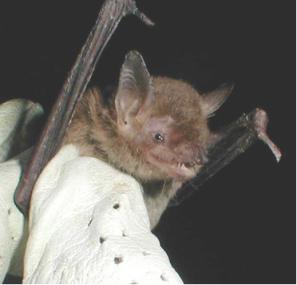Cave mouse ear
| Cave mouse ear | ||||||||||||
|---|---|---|---|---|---|---|---|---|---|---|---|---|

Cave mouse ear ( Myotis velifer ) |
||||||||||||
| Systematics | ||||||||||||
|
||||||||||||
| Scientific name | ||||||||||||
| Myotis velifer | ||||||||||||
| ( Allen , 1890) |
The cave mouse ear ( Myotis velifer ) is a bat species from the smooth-nosed family (Vespertilionidae), which is native to North and Central America.
description
The cave mouse ear is one of the largest mouse ears in North America with an average total length of 99.5 mm and a weight of over 12 g . It differs morphologically from M. thysanodes by a pronounced crest . Externally, in contrast to M. thysanodes , M. velifer does not have a row of stubbly hairs on the edge of the tail membrane . When placed in front, the ears only reach up to the muzzle and not beyond it. The forearm is 35–46 mm longer than that of other mouse ears in North America, and longer in females than in males ( sexual dimorphism ). The coat color varies between light brown and black-brown. In regions where the animals are exposed to high levels of humidity and ammonia in caves , the fur may be bleached.
Way of life
Myotis velifer , like most bats, is nocturnal and feeds on insects, with moths and beetles being the preferred prey. Foraging takes place during two main activity periods shortly after sunset and shortly before sunrise. During one of these periods, a single individual can ingest up to 2.7 g of insects with a flight speed of up to 15 km / h.
Similar to the moulting of birds , the cave mouse ear changes its coat once a year, usually in July and August. The males do this while the females are still raising their young. The females wait to change their coat until they have weaned their young. The entire coat change takes about a month.
The animals spend the day in groups of up to 5,000 individuals in caves. Myotis velifer hibernates in caves in its eastern range and in Mexico . The populations in Kansas and Texas remain in their area, while most animals from Arizona probably do not winter in the same region in which they spend their summer. Thus, the cave mouse ear belongs to the migrating bats.
During hibernation, the animals lose an average of a quarter of their body weight. The body temperature of the cave mike's ear fluctuates between 1 ° C and 10 ° C during hibernation, with the animals waking up from time to time to urinate or to look for another place to sleep. Myotis velifer is one of those bat species that hibernate in caves and prefer high humidity and the presence of water. The measured air humidity near a group of bats hibernating in Texas reached almost 100%. In addition to the high humidity, the animals prefer windless corners, which is why Myotis velifer is often found in crevices and not freely hanging. Myotis velifer often shares its winter quarters with other bat species such as the Mexican bulldog bat ( Tadarida brasiliensis ) or other mouse-ears such as M. yumanensis .
Among the known predation of the cavity mouse ear include Rough-legged Buzzard ( Buteo cinereus ), Kestrel ( Falco sparverius ) and Barn Owl ( Tyto alba ) and raccoons (Procyon Procyon) Streifenskunks ( Mephitis mephitis ) Katzenfrette ( Bassariscus astutus ) urocyon ( Urocyon cinereoargenteus ) Corn snakes ( Pantherophis guttatus ) and coastal lyre snakes ( Trimorphodon biscutatus ). In addition, there are observations that American bush rats ( Neotoma micropus ) prey on young Myotis velifer .
Reproduction
As a rule, females become sexually mature in their first year, but males only in their second year of life. The cave monkey mates in autumn and possibly in waking phases during hibernation. The females store the sperm through the winter; the ovulation and subsequent fertilization of the egg takes place after hibernation held in the spring. Shortly before birth, the females gather in nurseries under bridges, in buildings or in caves. The birth takes about 20 minutes. The skin of the newborn is pink, with the exception of the wings, ears, and face, which have brown pigmentation. The body is thinly haired with whitish fur. With an average weight of 3.0 g, the newborns weigh about a quarter of the mother. After 9-10 weeks, the pups reach the weight of a full-grown animal. The first flight attempts are made at the age of 3 weeks, and at 4 weeks the cubs go looking for food. After about 6 weeks, the young are weaned. As long as the young are not yet independent, the mothers leave them in the nursery while the adult animals go in search of food.
distribution and habitat
The cave mouse ear occurs in the north from Nebraska to Honduras in the south. The species inhabits evergreen or pine - or pine- oak forests of higher elevations, but can also be found in lower elevations in floodplains and regions with desert-like bush vegetation. Their population is classified as safe by the IUCN .
literature
- JH Fitch, KA Shump, AU Shump (1981) Myotis velifer . In: Mammalian Species , No. 149, pp. 1-5
